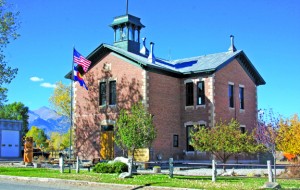By Susan Tweit
It’s fall, and as the days shorten, I miss the sunlight, but I revel in the chance to star-gaze. Long nights combine with our clear, dry high-country air to provide perfect conditions for viewing the night sky.
Just before going to bed this time of year, Richard and I slip outside and turn our heads to the sky, searching for the dazzling river of the Milky Way, picking out the planets and their progression, and identifying the dot-to-dot patterns of the constellations.
Sadly, light pollution has erased the once-ordinary view of the stars in most cities and urban areas; even in uncrowded rural landscapes, badly-placed yard or security lights can blot out neighbors’ view of the night sky.
Light pollution is a serious problem. According to the National Oceanic and Atmospheric Administration, more than 80 percent of Americans live where the Milky Way is no longer visible, and fewer than half of us have ever seen heaven’s river of stars at all.
Light pollution is surprisingly expensive, both in terms of dollars and energy. The wasted energy consumed by mis-aimed lights—lights that shine upward at the sky or outward in our eyes instead of down at the areas that need illuminating, or lights left on all night where they’re not needed—costs us about $2.2 billion each year, and pours 14.7 million tons of carbon dioxide into the atmosphere.
It’s also bad for our health. Excess night lighting disrupts the production of melatonin and interferes with the circadian “clock” governing our bodies. Research links excess night lighting with health issues as diverse as weight gain, depression, insomnia, diabetes, nearsightedness, heart disease, and promoting the growth of breast and other cancers.
Poorly aimed lights are actually dangerous, creating areas of glare that temporarily blind or distract drivers and pedestrians alike.
Light pollution also degrades the “night ecosystem,” the natural darkness that cues nocturnal animals, from bats and fireflies to moose and frogs, to go about their business. Nighttime lighting also misdirects and thus kills newly-hatched sea turtles and birds in migration.
Nighttime lighting stresses plants by artificially lengthening the days and thus skewing seasonal cues; deciduous trees near lights may keep their leaves longer in fall, for instance, and then suffer from frost-burn and dehydration.
How can you safeguard your view of the stars, your health, and the nighttime ecosystem? Eliminate unnecessary night lighting.
Aim indispensable lighting at the ground, not upward – if a light hits you in the eyes, it needs to be re-aimed or shielded. Put yard lights and security lights on motion sensors.
And don’t forget to go out regularly to admire the unpolluted night sky!
For more information: Visit the International Dark-Sky Association website for a directory of safe lighting, www.darksky.org. See how simple and effective shielded lights are in a charming night-sky simulation complete with meteors and hooting owls at the British “Need-Less” Campaign’s website, www.need-less.org.uk. Scroll to the bottom of the page for the animation.
Copyright 2010 Susan J. Tweit.
Award-winning writer Susan J. Tweit is the author of 12 books, and can be contacted through her web site, susanjtweit.com or her blog, susanjtweit.typepad.com/walkingnaturehomeHere is a short video addressing issues of light pollution.


